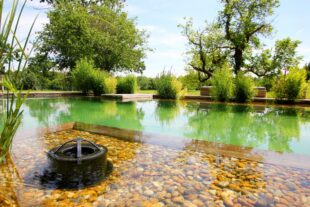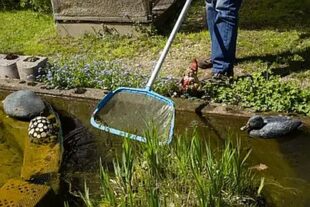Introduction
 Imagine sitting by your garden pond, surrounded by lush greenery and the soothing sound of water trickling over rocks. For those of us who have been building and nurturing small garden ponds throughout our lives, this scene is not just a vision but a cherished reality. The joy of crafting these miniature aquatic worlds, teeming with life and beauty, is truly something special. In this article, we will delve into the heart of pond care – maintaining water clarity. We’ll explore strategies, tips, and personal insights that come from a lifelong passion for these watery sanctuaries.
Imagine sitting by your garden pond, surrounded by lush greenery and the soothing sound of water trickling over rocks. For those of us who have been building and nurturing small garden ponds throughout our lives, this scene is not just a vision but a cherished reality. The joy of crafting these miniature aquatic worlds, teeming with life and beauty, is truly something special. In this article, we will delve into the heart of pond care – maintaining water clarity. We’ll explore strategies, tips, and personal insights that come from a lifelong passion for these watery sanctuaries.
Understanding the Importance of Water Clarity
Water clarity isn’t just about aesthetics; it’s a window into the overall health of your pond ecosystem. Crystal clear waters not only enhance the visual appeal of your pond but also provide a safe and balanced environment for aquatic life. Clear water allows sunlight to reach submerged plants, aiding photosynthesis, while also ensuring proper visibility for fish and other inhabitants.
1. The Power of Good Filtration
When it comes to maintaining water clarity, a robust filtration system is your best friend. Over the years, I’ve come to appreciate the importance of investing in quality filtration equipment. Mechanical and biological filters work in tandem to remove debris, excess nutrients, and harmful substances from the water. Regularly cleaning and maintaining these filters will go a long way in keeping your pond water clear.
2. Mindful Plant Selection
 Just as you carefully choose plants for your garden, selecting the right aquatic plants for your pond is essential. Floating plants like water lilies provide shade, reducing sunlight exposure and curbing excessive algae growth. Submerged plants, such as hornwort and anacharis, play a crucial role in nutrient absorption. These plants not only contribute to water clarity but also create a harmonious and balanced ecosystem.
Just as you carefully choose plants for your garden, selecting the right aquatic plants for your pond is essential. Floating plants like water lilies provide shade, reducing sunlight exposure and curbing excessive algae growth. Submerged plants, such as hornwort and anacharis, play a crucial role in nutrient absorption. These plants not only contribute to water clarity but also create a harmonious and balanced ecosystem.
3. Balancing Fish Population
Fish add life and vibrancy to your pond, but an overcrowded fish population can lead to cloudy water due to excess waste. As a lifelong enthusiast of garden ponds, I’ve learned that maintaining a suitable fish-to-water ratio is vital. Avoid overstocking and keep an eye on fish behavior. If they show signs of stress or slow swimming, it might be time to reevaluate the number of fish in your pond.
4. Regular Debris Removal
Leaves, twigs, and other debris falling into your pond can disrupt the delicate balance of its ecosystem. Skimming the surface regularly and using a pond net to catch debris before it settles at the bottom can prevent excess organic matter from decaying and clouding the water. My personal approach to debris removal is a daily ritual, allowing me to connect with my pond while ensuring its cleanliness.
5. Beneficial Bacteria Applications
 Introducing beneficial bacteria to your pond can significantly improve water clarity. These bacteria help break down organic waste and excess nutrients, reducing the chances of algae blooms and murky water. As someone who has witnessed the transformative effects of these bacteria in my ponds, I can attest to their positive impact on water quality.
Introducing beneficial bacteria to your pond can significantly improve water clarity. These bacteria help break down organic waste and excess nutrients, reducing the chances of algae blooms and murky water. As someone who has witnessed the transformative effects of these bacteria in my ponds, I can attest to their positive impact on water quality.
Conclusion
Building and caring for garden ponds is a labor of love that rewards us with moments of tranquility and connection with nature. The journey to maintaining crystal clear waters is both an art and a science, blending personal dedication with tried-and-true strategies. As someone who has been cultivating these aquatic havens throughout my life, I can confidently say that the effort put into sustaining water clarity is a small price to pay for the immense joy and fulfillment these ponds bring. So, roll up your sleeves, embrace the care these ponds deserve, and watch as your pond’s water clarity becomes a reflection of your passion and dedication.
